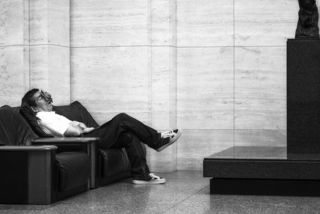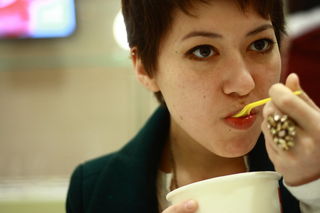Sleep
How to Use Your Bed
Use it for these three things and these three things only.
Posted March 8, 2020 Reviewed by Hara Estroff Marano

This is the third installment of “The Sleep Suite,” a six-part series of posts on sleep, aging, and wellness. Each will include practical takeaways intended to optimize your physical and psychological health.
I recently started rotating through a Veterans Affairs (VA) hospital; not unusual for many clinical psychology residents. The vets insist on calling me “doc” no matter how many times I try to correct and convince them otherwise—to explain the (embarrassingly) complicated hoops through which I must continue jumping to finally earn the title.
“Doc,” they insist anyway, “why can’t I fall asleep in my bed? I sleep like a baby in my chair but when I try to sleep in my bed, these puppies (pointing to eyes) pop wide open and I just can’t seem to shut them.”
I reassuringly educate them about conditioned arousal, a common and reliable indicator of clinical insomnia.

Use your bed for three things only
Sleep quality depends on many factors—daytime energy expenditure, daily regularity, stimulant use, et cetera. It also depends on how you use your bed and what meaning your brain learns to assign to it.
Use the bed for three things and three things only—the 3 S’s—(1) sleep, (2) sex, (3) and sickness. Everything else—watching television, reading, working, arguing, mindlessly scrolling through your phone, tablet, or laptop—needs to happen outside of it. Coined stimulus control, it works. So well, in fact, that some consider it an effective monotherapy for insomnia.
Stimulus control and conditioned arousal
In operant conditioning, stimulus control refers to the idea that any one stimulus or cue (i.e. bed) may elicit many behaviors (i.e. sleepiness/wakefulness) depending on the history of learning or conditioning.
Among “healthy” sleepers, the bed elicits associations of relaxation and sleep, but usually not for people with insomnia.
Why? Because people with insomnia tend to spend more time awake in bed than asleep. Over time and iterations of pairing the bed with sleep-disruptive behaviors like worrying, watching television, tossing and turning “trying” to fall asleep, the bed morphs into a cue for wakefulness rather than for sleep. Essentially, the brain thinks: Ah, the bed! The place where I worry and feel frustrated! The place where I...[verbs besides the 3 S’s here].
This conditioned arousal maintains insomnia and explains why many patients can fall asleep fairly easily in other places, like a recliner or couch but awaken upon transitioning to the bed.
Putting bad behavior to bed: A counterintuitive approach

Chew on this: If you didn’t feel hungry, would you force yourself to sit at the kitchen table and try to make yourself feel hungry? Or would you go off, work up an appetite, and return to it when you felt hungry?
The same logic applies to sleep.
To extinguish the association of the bed with wakefulness, and to restore the association of the bed with sleep, get out of bed when your attempts to sleep start feeling effortful or annoying, typically after 15-30 minutes. But no need to clock-watch—let your feelings guide you on this one. As soon as you start feeling frustrated, get up.
Practicing stimulus control, step by step:
Step 1: Get out of bed if you can’t fall asleep within 15-30 minutes. Even healthy sleepers require time to fall asleep, so use this parameter as a guideline, not a prescription. More importantly, when you notice yourself feeling frustrated, anxious, or annoyed about your inability to sleep, get out of bed. People with insomnia often mistakenly believe that spending excessive time in or near the bed increases their chances of sleeping, but this actually weakens the stimulus-response relationship between the bed and sleep.
Step 2: Go into another room with the lights off or low and avoid using light-emitting devices. Light sends signals to the photoreceptors in your retinas, prompting the suprachiasmatic nucleus (SCN) to stop producing drowsiness-promoting melatonin. Light interrupts the production of melatonin; darkness facilitates it. Blue light emitted from devices can prolong sleep onset and attenuate the duration of REM sleep, increasing sleepiness upon waking.

Step 3: Do something relaxing, not stimulating. Find what works for you, but focus on rote, relaxing, and mindless activities. For many, helpful options include: (1) practicing guided relaxation; (2) praying; (3) doing light reading or working a simple puzzle, or (4) folding laundry. Refrain from doing anything that gets your system particularly revved up, like exercising, vigorous housework, smoking or drinking alcohol. Passive body heating, like taking a warm bath or shower, may also help.
Step 4: Go back to bed when you notice symptoms of sleepiness return. When your body feels hungry, it tells you. Similarly, your body tells you when it feels sleepy with heaviness in your eyes, head, and body. Go back to bed only when you notice those cues. Learn to differentiate sleepiness from feeling tired, which instead refers to a psychological, emotional, and spiritual state of depletion.
Step 5: Rinse and repeat. With time, patience, and consistent application of stimulus control principles, your brain will relearn to associate the bed with sleep.
Other considerations:
Providers typically contraindicate or adjust stimulus control for persons with mania, epilepsy, and parasomnias or those at risk of falling. Consult with your doctor to discuss your options if you have any of these conditions.
P.S.: You can have sex other places, too.
P.S.S.: Sweet dreams.
Facebook image: fizkes/Shutterstock
References
Bootzin, R.R. (1972). A stimulus control treatment for insomnia. Proceedings of the 80th Annual Convention of the American Psychological Association, 395-396.
Bootzin, R. R., & Perlis, M. L. (2011). Stimulus Control Therapy. In Behavioral Treatments for Sleep Disorders (pp. 21-30). Elsevier Inc.. https://doi.org/10.1016/B978-0-12-381522-4.00002-X
Dautovich et al. (2010). Tackling sleepiness: Psychological treatment options for insomnia. Nature and Science of Sleep, 10(2), 23-27.
Haghayegh et al. (2019). Before-bedtime passive body heating by warm shower or bath to improve sleep: A systematic review and meta-analysis. Sleep Med Rev, 46, 124-135.
Walker, M. (2017). Why We Sleep: Unlocking the power of sleep and dreams. Scribner, New York, NY.




